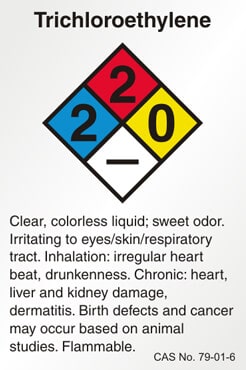Scientists believe a ubiquitous environmental contaminant used in household products such as carpet cleaners, shoe polishes, and carpet cleaners might be responsible for the development of neurodegenerative movement disorders such as Parkinson’s disease (PD). Parkinson’s disease is already one of the fastest-growing neurological disorders globally, with developing nations reporting an increase of over 30% in the last ten years. The number expects to double again in the next 25 years. Currently, many cases of Parkinson’s disease are diagnosed as idiopathic (no apparent cause), Yet leading neurologists believe that one of the primary reasons for the rapid growth is due to a universal organic solvent is known as Trichloroethylene (TCE).
What is TCE (Trichloroethylene) used for?
Trichloroethylene is a halogenated hydrocarbon (halocarbons). These hydrocarbon compounds have at least one hydrogen atom replaced by a halogen atom, such as chlorine, fluorine, or bromine. Emil Fischer first synthesized TCE in 1864, and over the last 100 years, the chemical has had much industrial usage. Due to its age and widespread use, tce chemistry is one of the most severe environmental contaminants. New research suggests that TCE is a direct causative factor for several diseases, including liver cancer, pancreas cancer, and prostate cancer. TCE is also shown to damage fetal cardiac development and cause neurotoxicity.[1] Trichloroethylene has also been found as a risk factor in the development of common neurodegenerative disorders such as ALS, MND, Alzheimers, and most recently Parkinson’s disease.

However, there is still some variance across multiple epidemiological studies assessing TCE-related exposure and risk for developing PD. Also, there is still a degree of uncertainty about how Trichloroethylene causes toxicity to neurons, prevent neurogenesis and damage the dopaminergic system.[2]
The most apparent evidence for the risk of Trichloroethylene to humans has been derived from industrial workers exposed to the chemicals in a workplace setting. A 2012 peer-review in the Annals of Neurology found that Trichloroethylene is “a risk factor for Parkinsonism.” And a 2015 research paper echoed those findings and found direct exposure tce chemical increased the risk of developing Parkinson’s six times more than people who are not exposed to Trichloroethylene (TCE) in the workplace
The study seems to confirm that such widely used and common environmental contaminants can increase the risk of developing Parkinson’s or other neurodegenerative disorders and pose a considerable risk to public health. Most recently, the US Department of Labor also issued guidance on the use of TCE, stating that: “The Board recommends exposures to carbon disulfide (CS2) and trichloroethylene (TCE) be presumed to cause, contribute, or aggravate Parkinsonism.”
Does Trichloroethylene cause cancer?
Trichloroethylene is classified as a carcinogen and cancer of the cervix, non-Hodgkin lymphoma, autoimmune diseases, cholangiocarcinomas, renal cell carcinoma, lung cancer, and cancer lymphatic system, male  breast tissue cancer, fetal cardiac defects, and lead to mitochondrial dysfunction. The direct relationship to developing Parkinson’s has been overlooked because exposure to TCE can happen decades before it manifests itself and cancer. While some exposed patients can show symptoms immediately, most others may unknowingly live or work in contaminated areas for most of their adult lives before developing any symptoms related to Parkinson’s disease.
breast tissue cancer, fetal cardiac defects, and lead to mitochondrial dysfunction. The direct relationship to developing Parkinson’s has been overlooked because exposure to TCE can happen decades before it manifests itself and cancer. While some exposed patients can show symptoms immediately, most others may unknowingly live or work in contaminated areas for most of their adult lives before developing any symptoms related to Parkinson’s disease.
Patients living in sites already known to be contaminated with hazardous materials such as TCE are especially at high risk of exposure. Some countries such as Canada already heavily regulate TCE, and the chemical is also banned in the EU without special permits. It is estimated that over 1 Billion pounds of toxic chemicals are still used annually around the world. In 2018, more than 120 Million pounds of TCE were released into the environment, mainly from industrial sites, which contaminate soil, water, and air. It is estimated that trichloroethylene products can be found in over 25% of groundwater in developed nations, with that number possibly doubling for developing nations.
In the United States, EPA regulations considered a maximum concentration of five parts per billion to be “safe” for TCE in drinking water. In severe contamination cases, residents and workers are believed to have been exposed to over 3,000 times the average level of contaminants permitted by accepted safety standards. There are already dedicated memorial sites known as “Babyland” established to honor the children of military personnel who have died after the pregnant mothers were exposed to TCE-tainted water supply while living on the military bases. Researchers do not believe that low concentrations of TCE in drinking water are enough to cause Parkinson’s or severe illness. Still, studies have linked contaminated well water as a direct cause of Parkinson’s disease not just from TCE but also to other potent pesticides like the herbicide paraquat, a common weedkiller still being used in countries around the world.[3]
How can we prevent exposure to Trichloroethylene?
A straightforward way to avoid exposure is using activated carbon filtration water devices which can help significantly reduce TCE chemicals in drinking water. For better protection, it’s better to have the entire house on a filtration system as activities like bathing or inhaling vapors from toxic soil or groundwater is very difficult to avoid. Policymakers and doctors around the world are asking for more effective government involvement in testing, proactive monitoring, and remediation of TCE-contaminated sites. Raising awareness of Trichloroethylene will also help many people avoid potentially fatal practices. Failure to address this issue will continue to make matters worse and negatively affect millions of people’s health.
Published Clinical Citations
[1] ^De Miranda BR , Greenamyre JT . Trichloroethylene, a ubiquitous environmental contaminant in the risk for Parkinson’s disease. Environ Sci Process Impacts. 2020 Mar 1;22(3):543-554. doi: 10.1039/c9em00578a. Epub 2020 Jan 30. PMID: 31996877; PMCID: PMC7941732.https://pubmed.ncbi.nlm.nih.gov/31996877/
[2] ^ Liu, M., Shin, E. J., Dang, D. K., Jin, C. H., Lee, P. H., Jeong, J. H., Park, S. J., Kim, Y. S., Xing, B., Xin, T., Bing, G., & Kim, H. C. (2018). Trichloroethylene and Parkinson’s Disease: Risk Assessment. Molecular neurobiology, 55(7), 6201–6214. https://doi.org/10.1007/s12035-017-0830-x
[3] ^ Singthong S, Pakkong P, Choosang K, Wongsanit S. Occupational health risks among trichloroethylene-exposed workers in a clock manufacturing factory. Glob J Health Sci. 2014 Aug 22;7(1):161-72. doi: 10.5539/gjhs.v7n1p161. PMID: 25560356; PMCID: PMC4796495 https://pubmed.ncbi.nlm.nih.gov/25560356/.

